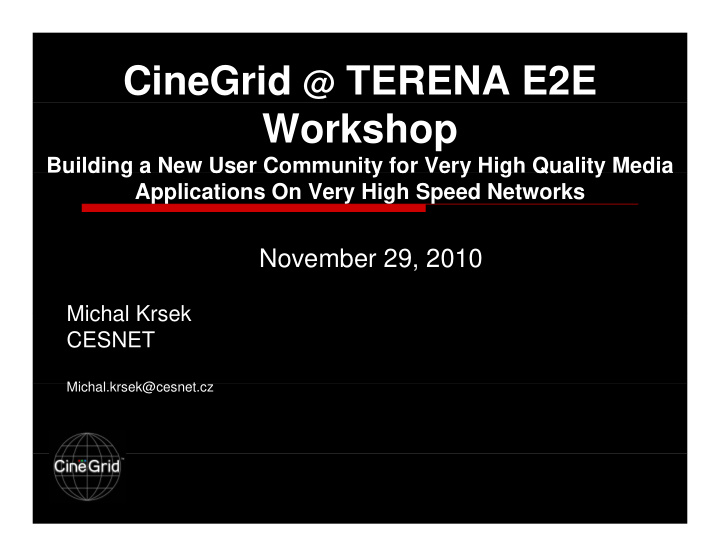



CineGrid @ TERENA E2E Workshop Building a New User Community for Very High Quality Media u d g a e Use Co u ty o e y g Qua ty ed a Applications On Very High Speed Networks November 29, 2010 Michal Krsek Michal Krsek CESNET Mi h l k Michal.krsek@cesnet.cz k@ t
What is CineGrid? CineGrid is a non-profit international membership CineGrid is a non-profit international membership organization. CineGrid’s mission is to build an interdisciplinary community focused on the research development and community focused on the research, development, and demonstration of networked collaborative tools to enable the production, use and exchange of very high-quality digital media over high-speed photonic networks. Members of CineGrid are a mix of media arts schools, research universities, scientific laboratories, post- production facilities and hardware/software developers production facilities and hardware/software developers around the world connected by 1 Gigabit Ethernet and 10 Gigabit Ethernet networks used for research and education.
CineGrid F Founding Members di M b Cisco Systems Keio University DMC Lucasfilm Ltd. NTT Network Innovation Laboratories Pacific Interface Inc. Pacific Interface Inc Ryerson University/Rogers Communications Centre San Francisco State University/INGI Sony Electronics America University of Amsterdam University of California San Diego/Calit2/CRCA University of Illinois at Urbana-Champaign/NCSA University of Illinois Chicago/EVL University of Illinois Chicago/EVL University of Southern California, School of Cinematic Arts University of Washington/Research Channel
CineGrid I Institutional Members tit ti l M b Academy of Motion Picture Arts and Sciences, STC y California Academy of Sciences Cinepost, ACE Prague Dark Strand i2CAT JVC America JVC America Korea Advanced Institute of Science and Technology (KAIST) Louisiana State University, Center for Com and Tech Mechdyne Meyer Sound Laboratories Nortel Networks Northwestern University, iCAIR Naval Postgraduate School Renaissance Center North Carolina (RENCI) Royal Swedish Institute of Technology Royal Swedish Institute of Technology SARA Sharp Corporation Japan Sharp Labs USA Tohoku University/Kawamata Lab U i University of Manitoba, Experimental Media Centre it f M it b E i t l M di C t Waag Society
CineGrid Network/Exchange Members AMPATH CANARIE CENIC CESNET CzechLight C hLi ht Internet 2 JA.NET Japan Gigabit Network 2 National LambdaRail National LambdaRail NetherLight NORDUnet Pacific Wave Pacific North West GigaPOP Pacific North West GigaPOP PIONEER RNP Southern Light StarLight g SURFnet WIDE
2001 NTT Network Innovations Laboratory NTT Network Innovations Laboratory “First Look” at 4K Digital Cinema
2004 “First Look” at 100 Mpixel OptIPortal Scientific Visualization and Remote Collaboration
CineGrid: A Scalable Approach Tiled Displays Camera Arrays More 1 1 - 24 Gbps 24 Gbps UHDTV (far future) UHDTV (far future) 8K x 60 4K 2 x 24/30 Stereo 4K (future) 500 Mbps - 15.2 Gbps SHD (Quad HD) SHD x 24/25/30 250 Mbs - 6 Gbps 4K x 24 250 Mbps - 7.6 Gbps 250 Mbps 7.6 Gbps 2K 2 x 24 Digital Cinema Digital Cinema 2K 2 24 2K x 24 200 Mbps - 3 Gbps HD 2 x 24/25/30 HD 2 x 24/25/30 Stereo HD Stereo HD HDTV HDTV x 24/25/30/60 20 Mbps - 1.5 Gbps 5 - 25 Mbps Consumer HD HDV x 24/25/30/60
CineGrid Project Run over the Global Lambda Integrated Facility (GLIF) Backbone Integrated Facility (GLIF) Backbone 2008 GLIF Visualization by Bob Patterson, NCSA/UIUC
CineGrid Projects: “Learning by Doing” CineGrid @ AES 2006 @ CineGrid @ iGrid 2005 CineGrid @ iGrid 2005 CineGrid @ Holland Festival 2007 CineGrid @ GLIF 2007
CineGrid Exchange CineGrid faces a growing need to store and distribute its CineGrid faces a growing need to store and distribute its own collection of digital media assets. The terabytes are piling up. Members want access to the materials for their experiments and demonstrations. Pondering “The Digital Dilemma” published by AMPAS in 2007, we studied the lessons learned by NDIPP and NARA, as well as the pioneering distributed storage research at Stanford (LOCKSS) and at UCSD (SRB and iRODS). CineGrid Exchange established to handle CineGrid’s own practical requirements AND to create a global-scale testbed with enough media assets at high enough quality, connected with fast enough networks, to enable exploration of strategic g , p g issues in digital archiving and digital library distribution for cinema, scientific visualization, medical imaging, etc.
CineGrid Exchange 2009 96 TB repositor added b R erson in Toronto 96 TB repository added by Ryerson in Toronto 48 TB repository added by CESNET in Prague 10 TB repository added by UIC/EVL in Chicago 10 TB repository to be added by AMPAS in Hollywood 10 TB it t b dd d b AMPAS i H ll d 16 TB repository to be added by NPS in Monterey By end of 2009 global capacity of CineGrid Exchange will By end of 2009, global capacity of CineGrid Exchange will be 256 TB connected via 10 GigE cyberinfrastructure Initiated CineGrid Exchange Project (CXP 2009) to g j ( ) implement multi-layer open-source asset management and user access framework for distributed digital media repository F Funding for CXP 2009 from AMPAS STC di f CXP 2009 f AMPAS STC Working Group: AMPAS, PII, Ryerson, UCSD, NPS, UW, UvA, Keio, NTT, CESNET, UIC
CineGrid apps as E2E use case Permanent interconnection of CX Permanent interconnection of CX Low bandwith for replications (~100 Mb/s) Small number of on-net localities Sometimes streaming (peaky traffic in about ~600 Mb/s) g (p y ) Demo support Ad-hoc networking (lambdas for 14 days) Typically one end at well known locality the other in network Typically one end at well known locality the other in network wilderness New applications (mostly uncompressed streaming, minimal jitter, zero latency) Bandwidth for now around 6-9 Gb/s Bandwidth for now around 6 9 Gb/s Real projects High bandwidth (1-5 Gb/s) Duration about months (3-6) Both end shall be in network wilderness
www cinegrid org www.cinegrid.org
Recommend
More recommend